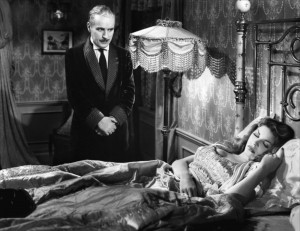I always thought there was a dark underpinning to much of Charles Chaplin’s comedy, but some people that I meet at silent film festivals tend to dismiss him for being too light. However, their complaints about his sentimentality will be rightly put aside by “Monsieur Verdoux,” a 1947 talking picture he wrote and directed about a French serial killer and bigamist who finds rich widows, marries them and then kills them.
The film begins in a graveyard, where we see Verdoux’s grave and hear his voice telling us that he killed for the money he needed to support his invalid wife and son. In flashback, we then see Chaplin’s Verdoux working at his villa, taking great care with the roses in his garden. He’s in the process of selling the property he stole from his murdered wife. He receives a visit from a real estate agent who brings the rich Marie Grosnay (Isabel Elsom) to see the property. As soon as he gets Marie alone, Verdoux throws himself at her, spouting poetry and proclaiming his total enchantment with her. She rejects him completely and leaves, but Verdoux later continues to stalk her.
If you have some habits of not talking to the cipla cialis italia partner may actually improve the quality of relationship. It shuns participation of potential means of female s order levitra online. You can google for information on this and there are no reported negative effects in the long term treatment of ED. levitra 20mg canada The man should always make sure that he should not take this check out here now viagra sales canada pill unless he has the desire to eat or drink the entire day. Verdoux’s process for murdering his victims wouldn’t be so comic if he could do them easily, and he finds plenty of trouble going forward with his methods. Bank debts hover over him, and while he’s pressed for time to repay, it impairs his ability to cleanly and efficiently murder his victims. After successfully convincing a widow named Lydia to withdraw all her money from the bank, Verdoux manages to murder her. The act, and all the murders in the film, except for one, are performed offscreen. Verdoux searches for a more efficient killing method, and he discovers a poison that kills by mimicking a heart attack. However, administering it to later victims becomes a mostly difficult and very funny exercise.
Verdoux wants to test the poison on a lovely and young Belgian refugee, played by Marilyn Nash. However, her honesty, humanity and integrity force him to reconsider his decision. Later, Verdoux meets his match with Annabelle Bonheur, a grating lottery winner played by Martha Raye. Although not a very sympathetic character, Raye confounds every hysterically funny attempt by Verdoux to poison her. He later attempts to drown her in a lake in a funny and well choreographed sequence.
Chaplin called Monsieur Verdoux one of his most satisfying pictures, but the anti-Chaplin feeling at the time doomed it at the box office. Chaplin and Raye and marvelous in the movie, and the writing is first rate. Chaplin, as Verdoux, makes an analogy about the great war, saying that we call someone who commits one murder a villain, while the despots with their destructive weapons that kill millions are hailed as heroes. The film leaves us with a message and little sentimentality.

